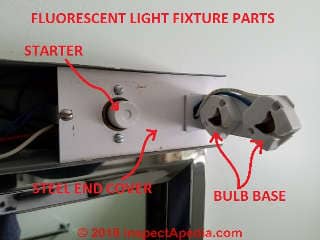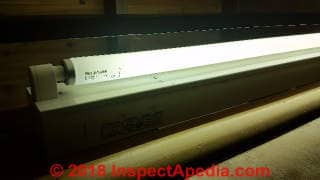 Fluorescent Ballast or Lamp Disposal
Fluorescent Ballast or Lamp Disposal
Laws & methods to dispose of of dead bulbs or transformers
- POST a QUESTION or COMMENT about building electrical systems, power, wiring, and flickering or dimming lights
How to dispose of a used or defective ballast or transformer used in fluorescent light fixtures.
This article series explains how to diagnose and repair fluorescent lights in buildings. We include links to codes and regulations for the disposal or re-cycling of old transformers or ballasts used in light fixtures. Some of these contain harmful PCBs.
InspectAPedia tolerates no conflicts of interest. We have no relationship with advertisers, products, or services discussed at this website.
- Daniel Friedman, Publisher/Editor/Author - See WHO ARE WE?
Fluorescent Light Ballast & Bulb Disposal Regulations
 How Much Mercury is in a Fluorescent Bulb?
How Much Mercury is in a Fluorescent Bulb?
Mercury, a hazardous substance, is present in fluorescent light tubes in both the vapor or gas in the tube and in the phosphor coating on the tube's interior surface. Depending on the fluorescent lamp design it can contain a quantity of mercury ranging from extremely small (less than 1 mg) to 100 milligrams.
About half of the fluorescent lamps sold in the U.s. contain about 5-10 mg of mercury, and another quarter of them contain 10-50 mg of mercury.
Not to worry, as long as the fluorescent lamp or tube is intact the mercury is contained safely inside the device and it's not a health hazard to building occupants.
[Click to enlarge any image]
Watch out: do not just toss these materials into the trash and do not deliberately break up old fluorescent bulbs.
You should also take care to avoid breaking fluorescent light tubes or lamps, both because of the hazard of the many fine shards of glass that will be produced and because breaking the tube releases mercury vapor and powder.
Instead, find out the regulations for your state and take the fluorescent bulbs, intact, to a recycling point. That may be easier than you think. In Minnesota I simply returned the bulbs to the hardware store where I purchased replacement bulbs, and where I was asked to pay a small state-regulated recycling fee.
Depending on where you live there may be a community recycling center that also accepts these bulbs.
How to Clean Up a Broken Fluorescent Bulb
Ok so you broke the fluorescent bulb! Now what? Some useful advice on how to clean up a broken fluorescent lamp bulb is provided by
- WHAT to DO if a COMPACT FLUORESCENT LIGHT (CFL) BULB or FLUORESCENT TUBE LIGHT BREAKS in YOUR HOME [PDF] U.S. EPA, retrieved 2018/09/17, original source: https://www.epa.gov/sites/production/files/documents/cflcleanup20120329.pdf
- What if I accidentally break a CFL, fluorescent bulb or mercury thermometer in my home? [PDF] Main Department of Environmental Protection, retrieved 2018/09/17, original source: https://www.maine.gov/dep/homeowner/cflbreakcleanup.html
In the U.S., accordance with the Resource Conservation & Recovery Act (RCRA), the mercury content in fluorescent lamps (bulbs) manufactured after 1990 was significantly-reduced; before 1990 these bulbs are higher in mercury content. Manufacturers such as GE labeled the newer low-mercury bulbs with an "Eco" suffix.
Depending on where you live there may be a small disposal fee that you must pay to assure proper handling of older bulbs or lamps containing mercury or to dispose of ballasts that may contain PCBs or other harmful chemicals.
Fluorescent Bulb Disposal Regulations & Procedures
 Photo: an Edison base (screw in conventional light bulb) compact fluorescent lamp.
Photo: an Edison base (screw in conventional light bulb) compact fluorescent lamp.
In the U.S. the following states prohibit disposing of any mercury-containing bulbs of any kind, regardless of the bulb age and type:
- California (2006) retrieved 2018/09/17 original source: https://www.calrecycle.ca.gov/HomeHazWaste/info
Excerpts:
As of February 9, 2006, all "u-waste" items are banned from the trash. ... [including] Fluorescent lamps and tubes. Includes fluorescent tubes, compact fluorescent lamps, metal halide lamps, and sodium vapor lamps. ... and other mercury-containing items.
...
Unless you are sure they are not hazardous, you should presume these types of devices need to be recycled or disposed of as hazardous waste and that they may not be thrown in the trash.
- Connecticut Compact Fluorescent Lamps, [PDF] retrieved 2018/09/17, original source: https://www.ct.gov/deep/cwp/view.asp?a=2708&q=378846
- Maine retrieved 2018/09/17, original source: https://www.maine.gov/dep/homeowner/fluorescent.html
Excerpt:
Maine law requires businesses and consumers to recycle all mercury-added light bulbs (a.k.a. “lamps”). When one of these bulbs breaks, mercury is released. Mercury-added lamps include compact fluorescent (CFL), linear fluorescent (straight, circline and u-tubes), neon lights, black lights, UV lights, and high intensity discharge (HID) bulbs. In Maine, it is illegal to throw mercury-added bulbs in the trash. - Massachusetts Fluorescent Lamp Disposal: Guidance for Conditionally Exempt Recycling Operations on Handling Products Containing Mercury [PDF] retrieved 2018/09/17, original source: https://www.mass.gov/files/documents/2016/08/vu/hgreguid.pdf
- Minnesota Compact Fluorescent Lights Product stewardship profile [PDF] retrieved 2018/09/17, original source: https://www.pca.state.mn.us/sites/default/files/w-ps2-02.pdf
- New Hampshire: Compact Fluorescent Light Bulbs and Mercury: What Consumers Should Know [PDF] (2011) retrieved 2018/09/17, original source: https://www.des.nh.gov/organization/commissioner/pip/factsheets/co/documents/co-19.pdf
Excerpt: ... it is against the law in New Hampshire to dispose of any mercury-containing products in landfills, incinerators, or transfer stations - New York Fluorescent and HID Lamps Hazardous Waste Lamp Management FAQs [PDF] retrieved 2018/09/17, original source: https://www.dec.ny.gov/chemical/8787.html and also https://www.dec.ny.gov/docs/materials_minerals_pdf/CFL_FAQ.pdf
- Rhode Island Fluorescent Bulb Disposal [PDF] retrieved 2018/09/17, original source: http://www.dem.ri.gov/programs/benviron/waste/pdf/flourbro.pdf
- Vermont, Fluorescent & HID Mercury Containing Lamps [PDF] retrieved 2018/09/17, original source: http://dec.vermont.gov/waste-management/solid/product-stewardship/mercury
- Washington State, LightRecycle program, retrieved 2018/09/17, original source: https://ecology.wa.gov/Waste-Toxics/Reducing-recycling-waste/Mercury-lights
Excerpt:
LightRecycle Washington allows Washington residents and businesses to recycle up to 10 mercury-containing lights per day for free at certain locations across the state. Recycling mercury-containing lights is important to protect our health and the health of our environment.
Special disposal procedures and regulations must be followed in those states, in accordance with the U.S. Federal Regulation 40 CFR Part 273 - Universal Waste Rule. Very helpful details about handling these materials are given by Lynch (un-dated), writing for GE and cited just below.
- IMERC, FACT SHEET: MERCURY USE in LIGHTING [PDF] (2015), retrieved 2018/09/17, original source: http://www.newmoa.org/prevention/mercury/imerc/factsheets/lighting_2015.pdf
- U.S. EPA, "Recycling and Disposal of CFLs and Other Bulbs that Contain Mercury", retrieved 2018/09/17, original source: https://www.epa.gov/cfl/recycling-and-disposal-cfls-and-other-bulbs-contain-mercury
Excerpt:
EPA recommends that consumers take advantage of available local options for recycling CFLs, fluorescent bulbs and other bulbs that contain mercury, and all other household hazardous wastes, rather than disposing of them in regular household trash.
Consumers can help prevent the release of mercury into the environment by taking advantage of available local options for recycling CFLs and other household hazardous wastes, rather than disposing of them in regular household trash. - Title 40, Parts 258, 260, 261, 264, 273, Code of Federal Regulations - retrieved 2018/09/17. The text of these regulations as of 17 Sept. 2018 can be obtained by US EPA links given at this original source: https://www.epa.gov/rcra/resource-conservation-and-recovery-act-rcra-regulations - the pertinent regulations include:
Part 258 – Criteria For Municipal Solid Waste Landfills
Part 260 – Hazardous Waste Management System: General
Part 261 – Identification And Listing Of Hazardous Waste
Part 264 – Standards For Owners And Operators Of Hazardous Waste Treatment, Storage, And Disposal Facilities
Part 273 – Standards For Universal Waste Management
Excerpt:
The RCRA regulations are contained in title 40 of the Code of Federal Regulations (CFR) parts 239 through 282.
The CFR is a collection of all federal regulations codified and enforced by all federal agencies. Title 40 – Protection of the Environment - contains all of the regulations governing EPA's programs.
In any given state, EPA or the state's hazardous waste regulatory agency enforces hazardous waste laws.
EPA encourages states to assume primary responsibility for implementing a hazardous waste program through state adoption, authorization and implementation of the regulations. - Lynch, Michael P., GE, General Electric: A SHORT GUIDE to LAMP & BALLAST DISPOSAL [PDF], retrieved 2018/09/16, original source: https://www.geappliances.com/email/lighting/specifier/downloads/A_Short_Guide_to_Lamp_Disposal.pdf
...
Continue reading at FLUORESCENT LAMP INSTRUCTIONS, PARTS, REPLACEMENTS or select a topic from the closely-related articles below, or see the complete ARTICLE INDEX.
Or see this
Article Contents
- FLUORESCENT LIGHTING GUIDE INDOORS for Indoors and Guide to Using Compact Fluorescent Lights
- FLUORESCENT LIGHTS COMPACT INDOOR
- FLUORESCENT LIGHT REPAIRS
- HOW FLUORESCENT LIGHTS WORK
- ELECTRIC POWER LOSS / FLICKERING LIGHTS
- DIAGNOSE a BAD FLUORESCENT LAMP / BULB
- LED BULB REPLACES FLUORESCENT
- REPLACE a FLUORESCENT LAMP / BULB
- FLUORESCENT LIGHT BALLAST TYPES
- FLUORESCENT LIGHT BULB CODES & TYPES
- FLUORESCENT LIGHT BULB PHOTOS
- FLUORESCENT LIGHT BULB COLOR TEMPERATURE
- FLUORESCENT LIGHT FLICKERING CAUSES
- FLUORESCENT LIGHT STARTER REPLACEMENT
- FLUORESCENT LIGHT TRANSFORMER / BALLAST REPLACEMENT
- FLUORESCENT LIGHT TRANSFORMER / BALLAST TYPES
- FLUORESENT BULB SOCKET TYPES
- FLUORESCENT LAMP CONNECTOR / SOCKET REPLACEMENT
- FLUORESCENT LIGHT FIXTURE BULB / BALLAST DISPOSAL
- FLUORESCENT LAMP INSTRUCTIONS, PARTS, REPLACEMENTS
- FLUORESCENT vs INCANDESCENT BULBS
Suggested citation for this web page
FLUORESCENT LIGHT FIXTURE BULB / BALLAST DISPOSAL at InspectApedia.com - online encyclopedia of building & environmental inspection, testing, diagnosis, repair, & problem prevention advice.
Or see this
INDEX to RELATED ARTICLES: ARTICLE INDEX to ELECTRICAL INSPECTION & TESTING
Or use the SEARCH BOX found below to Ask a Question or Search InspectApedia
Ask a Question or Search InspectApedia
Try the search box just below, or if you prefer, post a question or comment in the Comments box below and we will respond promptly.
Search the InspectApedia website
Note: appearance of your Comment below may be delayed: if your comment contains an image, photograph, web link, or text that looks to the software as if it might be a web link, your posting will appear after it has been approved by a moderator. Apologies for the delay.
Only one image can be added per comment but you can post as many comments, and therefore images, as you like.
You will not receive a notification when a response to your question has been posted.
Please bookmark this page to make it easy for you to check back for our response.
IF above you see "Comment Form is loading comments..." then COMMENT BOX - countable.ca / bawkbox.com IS NOT WORKING.
In any case you are welcome to send an email directly to us at InspectApedia.com at editor@inspectApedia.com
We'll reply to you directly. Please help us help you by noting, in your email, the URL of the InspectApedia page where you wanted to comment.
Citations & References
In addition to any citations in the article above, a full list is available on request.
- Our recommended books about building & mechanical systems design, inspection, problem diagnosis, and repair, and about indoor environment and IAQ testing, diagnosis, and cleanup are at the InspectAPedia Bookstore. Also see our Book Reviews - InspectAPedia.
- In addition to citations & references found in this article, see the research citations given at the end of the related articles found at our suggested
CONTINUE READING or RECOMMENDED ARTICLES.
- Carson, Dunlop & Associates Ltd., 120 Carlton Street Suite 407, Toronto ON M5A 4K2. Tel: (416) 964-9415 1-800-268-7070 Email: info@carsondunlop.com. Alan Carson is a past president of ASHI, the American Society of Home Inspectors.
Thanks to Alan Carson and Bob Dunlop, for permission for InspectAPedia to use text excerpts from The HOME REFERENCE BOOK - the Encyclopedia of Homes and to use illustrations from The ILLUSTRATED HOME .
Carson Dunlop Associates provides extensive home inspection education and report writing material. In gratitude we provide links to tsome Carson Dunlop Associates products and services.

